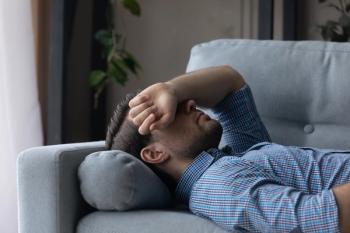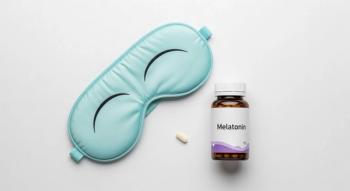
Recognition of Dopamine in Sleep-Wake Function May Improve PD Care
aytime sleepiness is common in patients with parkinsonism but has little to do with the amount of sleep these patients get and everything to do with dopaminergic dysfunction, according to David B. Rye, MD, PhD, associate professor of neurology at Emory University in Atlanta. "The idea is that if I sleep a lot, I shouldn't be so sleepy the next day, and if I sleep little, I should be very sleepy. This is doesn't hold true for patients with Parkinson disease [PD]. The loss of dopamine disrupts that banking system, or the sleep-wake homeostat," he said during a presentation at the 9th annual meeting of the American Society for Experimental Therapeutics, which met March 8 to 10 in Washington, DC. Addressing dopa- minergic tone during sleep might help ameliorate daytime symptoms of parkinsonism in general.
Daytime sleepiness is common in patients with parkinsonism but has little to do with the amount of sleep these patients get and everything to do with dopaminergic dysfunction, according to David B. Rye, MD, PhD, associate professor of neurology at Emory University in Atlanta. "The idea is that if I sleep a lot, I shouldn't be so sleepy the next day, and if I sleep little, I should be very sleepy. This is doesn't hold true for patients with Parkinson disease [PD]. The loss of dopamine disrupts that banking system, or the sleep-wake homeostat," he said during a presentation at the 9th annual meeting of the American Society for Experimental Therapeutics, which met March 8 to 10 in Washington, DC. Addressing dopaminergic tone during sleep might help ameliorate daytime symptoms of parkinsonism in general.
"If we look at the epidemiology of sleepiness in community-based samples of PD, incidence is about 7% to 14% versus 1% to 2% among healthy, age-matched controls. In clinical populations, numerous studies show a 20% to 50% incidence of pathological sleepiness in patients with PD. One third to one half of these patients meet the criteria for narcolepsy," said Rye, adding that research is suggesting that excessive daytime sleepiness might be a harbinger of incipient parkinsonism1 and of dementia.2
"PD is a prototypical disorder characterized by decreased dopamine in the major nigral striatal pathways in the brain, which contain about 80% to 85% of the brain's total dopamine," explained Rye. "Numerous drugs that affect dopamine when given systemically have a biphasic effect on sleep-wake function. At a low dose, these drugs act on D2 and D3 molecular subtype receptors. We see increases in slow wave sleep and REM [rapid eye movement] sleep and decreases in wakefulness. Higher doses presumably act on D1 and D5 receptors and have opposite effects; they decrease sleep and increase wakefulness."
Inputs and outputs of the dopaminergic pathway tie into a wide range of functions and behaviors in a person, according to Rye. "These neurons are 1 to 3 synapses away from autonomic input and also orexin input"-orexin being a key neuropeptide in sleep-wake modulation. "The outputs are directed to not just movement but a wide variety of responses in relation to cognition, affect, alertness, and other functions."
DOPAMINE AND CIRCADIAN RHYTHMS
Although the nuances of dopamine have been well studied, no one has described what dopamine does over 24 hours to illustrate how the neurotransmitter impacts circadian and homeostatic mechanisms, Rye contended. Amanda Freeman, a graduate student working in Rye's laboratory at Emory, however, headed up a revealing, yet unpublished experimental study on this.
Using telemetry to record the sleep-wake cycle and microdialysis to chart extracellular striatal dopamine levels in nonhuman primates subjected to a lights on at 7 am, lights off at 7 pm schedule, the student found that dopamine levels are at their highest at 7 am. "Levels essentially decrease throughout the day. The nadir is 3 pm, corresponding to the 'primate siesta.' Levels then go up later in the afternoon and evening, peaking just before the lights go off in anticipation of sleep-possibly a circadian alerting signal," reported Rye. "They then decrease up until about 10 pm and then progressively increase all night until wake time."
Importantly, Rye stressed, dopaminergic neurons do not increase their firing range across sleep. "Extracellular dopamine increases even though neurons are quiescent. Also interesting is that dopaminergic neurons do not express c-Fos under active conditions. This was a surprise to us," Rye commented. He added that serotonin has the same pattern; it increases in the striatum even though its effects are quiescent during sleep.
"Because dopamine is so important to the normal circadian cycle, sleep is important in improving motor symptoms," noted Rye. "If the residual dopamine that exists is increased because of sleep hygiene, then parkinsonian symptoms-including non-motor symptoms of PD-can be better controlled."
ASSESSMENT AND INTERVENTION
Although the diagnosis of PD can be easily made in a sleep laboratory, assessing excessive daytime sleepiness in patients with PD can be challenging. "Characteristic features of PD, such as irregularities in sleep-wake spindling, are apparent on polysomnography, but patients with PD are not good at keeping time and they are also terrible at telling you whether they've been asleep or are sleepy or not," said Rye. He cited a study by Merino-Andreu and colleagues3 showing that more than a third (38%) of a cohort of 47 patients with PD and excessive daytime sleepiness did not necessarily recall falling asleep during the day (a problem, of course, that ties into motor vehicle safety and other concerns that affect both the patient and society at large). Rather, in evaluating excessive sleepiness in patients with PD, it is preferable to interview persons close to the patient to get a more accurate view of the situation, a point confirmed in a soon-to-be published paper by Rye and fellow investigators.4
When diagnosing excessive sleepiness in PD and planning an intervention strategy, it is important to consider the various other factors that contribute to sleep dysfunction: comorbid conditions, such as dementia and depression; aging; and use of certain medications. Patient history, a clinical examination, and a laboratory examination that includes analysis of B12 and iron levels and an assessment for presence of hemochromatosis-which is associated with fatigue in 85% of affected patients-are recommended, said Rye. "Polysomnography is used to get objective data on impaired alertness. Sleep latency testing or maintenance of wakefulness testing during daytime naps provides objective data," Rye continued.
A symptom-based approach should be applied to treatment, according to Rye. "It would need to be determined whether the patient's sleep disorder is a sleep-onset insomnia, sleep maintenance insomnia, or hyperinsomnia; whether it involves vivid dreaming, hallucination, or excessive nocturnal movement such as in REM sleep behavior disorder."
References:
REFERENCES1. Abbott RD, Ross GW, White LR, et al. Excessive daytime sleepiness and subsequent development of Parkinson disease. Neurology. 2005;65:1442-1446.
2. Foley D, Monjan A, Masaki K, et al. Daytime sleepiness is associated with 3-year incident dementia and cognitive decline in older Japanese-American men. J Am Geriatr Soc. 2001;49:1628-1632.
3. Merino-Andreu M, Arnulf I, Konofal E, et al. Unawareness of naps in Parkinson's disease and in disorders with excessive daytime sleepiness. Neurology. 2003;60:1553-1554.
4. Trotti LM, Rye DB, Bliwise DL. Mov Dis. In press.
Newsletter
Receive trusted psychiatric news, expert analysis, and clinical insights — subscribe today to support your practice and your patients.

















